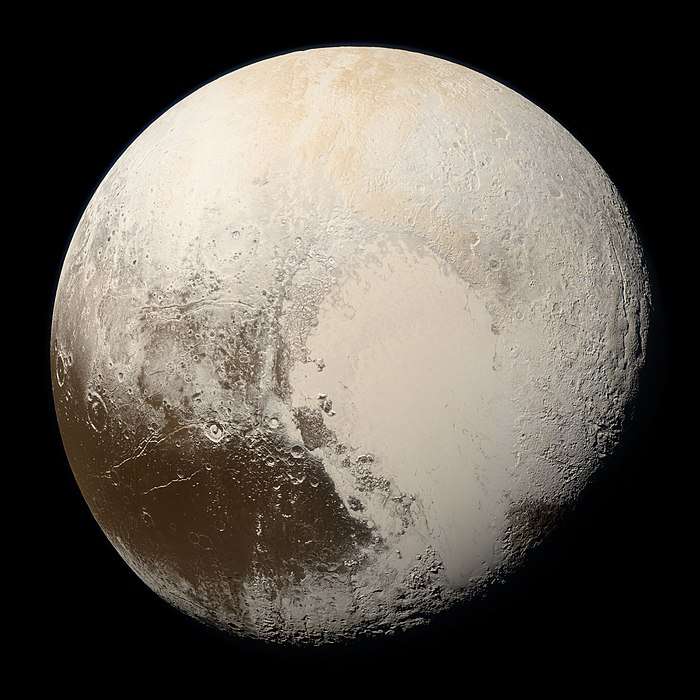50000 Quaoar
50000 Quaoar is a non-resonant trans-Neptunian object (cubewano) and a possible dwarf planet in the Kuiper belt, a region of icy planetesimals beyond Neptune. It measures approximately 1,121 km (697 mi) in diameter, about half the diameter of Pluto. The object was discovered by American astronomers Chad Trujillo and Michael Brown at the Palomar Observatory on 4 June 2002.[1] Signs of water ice on the surface of Quaoar have been found, which suggests that cryovolcanism may be occurring on Quaoar.[20] A small amount of methane is present on its surface, which can only be retained by the largest Kuiper belt objects.[21] In February 2007, Weywot, a synchronous moon in orbit around Quaoar, was discovered by Brown.[6] Weywot is measured to be 170 km (110 mi) across.[22] Both objects were named after mythological figures from the Native American Tongva people in Southern California. Quaoar is the Tongva creator deity and Weywot is his son.[2]
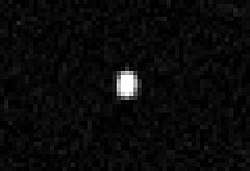 Quaoar imaged by the Hubble Space Telescope in 2002 | |
| Discovery [1] | |
|---|---|
| Discovered by | Chadwick A. Trujillo Michael E. Brown |
| Discovery site | Palomar Observatory |
| Discovery date | 4 June 2002 |
| Designations | |
| (50000) Quaoar | |
| Pronunciation | /ˈkwɑːwɑːr/, /ˈkwɑːoʊ.ɑːr/[lower-alpha 1] |
Named after | Qua-o-ar / Kwawar[2] (deity of the Tongva people) |
| 2002 LM60 | |
| TNO[3] · cubewano[4][5] distant[1] | |
| Orbital characteristics [3] | |
| Epoch 31 May 2020 (JD 2459000.5) | |
| Uncertainty parameter 3 | |
| Observation arc | 65.27 yr (23,839 days) |
| Earliest precovery date | 25 May 1954 |
| Aphelion | 45.488 AU (6.805 Tm) |
| Perihelion | 41.900 AU (6.268 Tm) |
| 43.694 AU (6.537 Tm) | |
| Eccentricity | 0.04106 |
| 288.83 yr (105,495 d) | |
| 301.104° | |
| 0° 0m 12.285s / day | |
| Inclination | 7.9895° |
| 188.927° | |
| 147.480° | |
| Known satellites | 1 (Weywot)[6] |
| Physical characteristics | |
| Dimensions | 1138+48 −34 × 1036+44 −31 km[lower-alpha 2] |
Mean diameter | 1110±5 (volume equivalent)[7] 1121±1.2 km (chord)[8] |
Mean radius | 555±2.5 (volume equivalent)[7] 560.5±0.6 km (chord)[8] |
| Flattening | 0.0897±0.006[7] |
| 3.83×106 km2[9] | |
| Volume | 7.02×108 km3[10] |
| Mass | (1.40±0.21)×1021 kg[7][11] |
Mean density | 1.99±0.46 g/cm3[7] 2.18+0.43 −0.36 g/cm3[12] |
Equatorial surface gravity | ≈ 0.29 m/s2 |
Equatorial escape velocity | ≈ 0.57 m/s |
| 8.8394±0.0002 h (single-peaked light curve)[13] | |
| 0.109±0.007[7] | |
| Temperature | ≈ 44 K[14] |
| IR (moderately red) B–V=0.94±0.01[15][16] V−R=0.64±0.01[15] V−I=1.28±0.02[16][17] | |
| 19.1 (opposition)[18] | |
| 2.737±0.008[18] 2.4 (assumed)[3][1] | |
| 40.4±1.8 milli-arcsec[19] | |
History
Discovery


Quaoar was discovered on 4 June 2002 by American astronomers Chad Trujillo and Michael Brown at the Palomar Observatory in the Palomar Mountain Range in San Diego County, California.[1] The discovery formed part of the Caltech Wide Area Sky Survey, which was designed to search for the brightest Kuiper belt objects using the Palomar Observatory's 1.22-meter Samuel Oschin telescope.[24] Quaoar was first identified in images by Trujillo on 5 June 2002, when he noticed a dim, 18.6-magnitude object slowly moving among the stars of the constellation Ophiuchus.[25][26] Quaoar appeared relatively bright for a distant object, suggesting that it could have a size comparable to the diameter of the dwarf planet Pluto.[27]
To ascertain Quaoar's orbit, Brown and Trujillo initiated a search for archival precovery images. They obtained several precovery images taken by the Near-Earth Asteroid Tracking survey from various observatories in 1996 and 2000–2002.[23] In particular, they had also found two archival photographic plates taken by astronomer Charles T. Kowal in May 1983,[26] who at the time was searching for the hypothesized Planet X at the Palomar Observatory.[28][29] From these precovery images, Brown and Trujillo were able to calculate Quaoar's orbit and distance. Additional precovery images of Quaoar have been later identified, with the earliest known found by Dr. Edward Rhoads on a photographic plate imaged on 25 May 1954 from the Palomar Observatory Sky Survey.[1][3]
Before announcing the discovery of Quaoar, Brown had planned to conduct follow-up observations using the Hubble Space Telescope to measure Quaoar's size.[30] He had also planned to announce the discovery as soon as possible and found it necessary to keep the discovery information confidential during the follow-up observations.[31] Rather than submitting his Hubble proposal under peer review, Brown submitted his proposal directly to one of Hubble's operators, who promptly allocated time to Brown.[31][32] While setting up the observing algorithm for Hubble, Brown had also planned to use one of the Keck telescopes in Mauna Kea, Hawaii, as a part of a study on cryovolcanism on the moons of Uranus.[31] This provided him additional time for follow-up observations and took advantage of the whole observing session in July to analyze Quaoar's spectrum and characterize its surface composition.[31][21]
The discovery of Quaoar was formally announced by the Minor Planet Center in a Minor Planet Electronic Circular on 7 October 2002.[26] It was given the provisional designation 2002 LM60, indicating that its discovery took place during the first half of June 2001.[26][33] Quaoar was the 1,512nd object discovered in the first half of May, as indicated by the preceding letter and numbers in its provisional designation.[lower-alpha 3] On that same day, Trujillo and Brown reported their scientific results from observations of Quaoar at the 34th annual meeting of the American Astronomical Society's Division for Planetary Sciences in Birmingham, Alabama. They announced Quaoar was the largest Kuiper belt object found yet, surpassing previous record holders 20000 Varuna and 2002 AW197.[30][24] Quaoar's discovery has been cited as Brown as having contributed to the reclassification of Pluto as a dwarf planet.[31] Since then, Brown has contributed to the discovery of larger trans-Neptunian objects, including Haumea, Eris, Makemake, and Gonggong.
Naming
Upon Quaoar's discovery, it was initially given the temporary nickname "Object X" as a reference to Planet X, due to its potentially large size and unknown nature.[31] At the time, Quaoar's size was uncertain, and its high brightness led the discovery team to speculate that it may be a possible tenth planet. After measuring Quaoar's size with the Hubble Space Telescope in July, the team began considering names for the object, particularly those from New World mythologies.[31] Following the International Astronomical Union's (IAU's) naming convention for minor planets, non-resonant Kuiper belt objects are to be named after creation deities.[33] The team settled on selecting names from Native American mythologies local to the Palomar Mountain region, the location where they discovered Quaoar. Through Internet searching, the team eventually decided upon the name Kwawar, the creator god of the Tongva people indigenous to the area around Los Angeles.[31][34] The Tongva were the first inhabitants of the Los Angeles Basin, where Michael Brown's institute, the California Institute of Technology, is located.[28]
In Tongva mythology, Kwawar (or Quaoar) is the creation force of the universe, singing and dancing deities into existence.[2] Quaoar has no form or gender, although the deity is generally referred to with masculine pronouns.[25][34] He first sings and dances to create Weywot (Sky Father), then they sing Chehooit (Earth Mother) and Tamit (Grandfather Sun) into existence. As they sang and danced deities into existence, the creation force became more complex as each joined the singing and dancing. Eventually, after reducing chaos to order, they created the great seven giants that upheld the world.[25][30] They then gave rise to the lower animals and eventually the first man and woman, Tobohar and Pahavit.[25]
Upon their investigation of names from Tongva mythology, Brown and Trujillo realized that there were existing members of the Tongva and considered contacting them for permission.[31] They consulted tribal historian Marc Acuña, who suggested that the name Kwawar was appropriate for the newly-discovered object.[25][34] The name was then changed to Qua-o-ar as this spelling was preferred among the Tongva.[31] However, the name's spelling was later reconsidered by Brown due to its ambiguous pronunciation resulting from the four-vowel combination uaoa—no other word in the English language has this particular combination of vowels.[31][lower-alpha 1] (Indeed, even if one takes the u to be part of the initial consonant qu, no other word in English has the vowel sequence aoa, though it occurs in the place name Paraoa.) Regardless, the name and discovery of Quaoar were publicly announced in October, though Brown had not sought approval of the name by the IAU's Committee on Small Body Nomenclature (CSBN).[31] Quaoar's name was announced before the official numbering of the object, which Brian Marsden—the head of the Minor Planet Center—remarked in 2004 to be a violation of the protocol during the time that the name of Sedna—another large trans-Neptunian object discovered by Brown—was announced.[31][35] Despite this, the name was approved by the CSBN, and the naming citation, along with Quaoar's official numbering, was published in a Minor Planet Circular on 20 November 2002.[36]
Quaoar was given the minor planet number 50000, which was not by coincidence but to commemorate its large size, being that it was found in the search for a Pluto-sized object in the Kuiper belt.[36] The large Kuiper belt object 20000 Varuna has been similarly numbered for a similar occasion.[37] However, subsequent even larger discoveries such as 136199 Eris were simply numbered according to the order in which their orbits were confirmed.[33]
Physical characteristics
.jpg)
Quaoar's albedo or reflectivity could be as low as 0.1, similar to Varuna's albedo of 0.127.[38] This may indicate that fresh ice has disappeared from Quaoar's surface.[39] The surface is moderately red, meaning that Quaoar is relatively more reflective in the red and near-infrared spectrum than in the blue.[20] The Kuiper belt objects Varuna and Ixion are also moderately red in the spectral class. Larger Kuiper belt objects are often much brighter because they are covered in more fresh ice and have a higher albedo, and thus they present a neutral color.[40] A 2006 model of internal heating via radioactive decay suggested that, unlike 90482 Orcus, Quaoar may not be capable of sustaining an internal ocean of liquid water at the mantle–core boundary.[41]
The presence of methane and other volatiles on Quaoar's surface suggest that it may support a tenuous atmosphere produced from the sublimation of volatiles.[14] With a measured mean temperature of ~ 44 K (−229.2 °C), the upper limit of Quaoar's atmospheric pressure is expected to be in the range of a few microbars.[14] Due to Quaoar's small size and mass, the possibility of Quaoar having an atmosphere of nitrogen and carbon monoxide has been ruled out, since the gases would escape from Quaoar.[14] The possibility of a methane atmosphere, with the upper limit being less than 1 microbar,[7][14] was considered until 2013, when Quaoar occulted a 15.8 magnitude star and revealed no sign of a substantial atmosphere, placing an upper limit to at least 20 nanobars, under the assumption that Quaoar's mean temperature is 42 K (−231.2 °C) and that its atmosphere consists of mostly methane.[7][14] The upper limit of atmosphere pressure was tightened to 10 nanobars after another stellar occultation in 2019.[8]
Mass and density
Because Quaoar is a binary object, the mass of the system can be calculated from the orbit of the secondary. Quaoar's estimated density of around 2.2 g/cm3 and estimated size of 1,121 km (697 mi) suggests that it is a dwarf planet. American astronomer Michael Brown estimates that rocky bodies around 900 km (560 mi) in diameter relax into hydrostatic equilibrium, and that icy bodies relax into hydrostatic equilibrium somewhere between 200 km (120 mi) and 400 km (250 mi).[42] With an estimated mass greater than 1.6×1021 kg, Quaoar has the mass and diameter "usually" required for being in hydrostatic equilibrium according to the 2006 IAU draft definition of a planet (5×1020 kg, 800 km),[43] and Brown states that Quaoar "must be" a dwarf planet.[44] Light-curve-amplitude analysis shows only small deviations, suggesting that Quaoar is indeed a spheroid with small albedo spots and hence a dwarf planet.[45]
Planetary scientist Erik Asphaug has suggested that Quaoar may have collided with a much larger body, stripping the lower-density mantle from Quaoar, and leaving behind the denser core. He envisioned that Quaoar was originally covered by a mantle of ice that made it 300 km (190 mi) to 500 km (310 mi) bigger than its present size, and that it collided with another Kuiper belt object about twice its size—an object roughly the diameter of Pluto, or even approaching the size of Mars.[46] This model was made assuming Quaoar actually had a density of 4.2 g/cm3, but more recent estimates have given it a more Pluto-like density of only 2 g/cm3, with no more need for the collision theory.[7]
Size
| Year | Diameter (km) | Method | Refs |
|---|---|---|---|
| 2004 | 1260±190 | imaging | [19] |
| 2007 | 844+207 −190 |
thermal | [47] |
| 2010 | 890±70 | thermal/imaging | [39] |
| 2013 | 1074±138 | thermal | [12] |
| 2013 | 1110±5 | occultation | [7] |
| 2019 | 1121±1.2 | occultation | [8] |
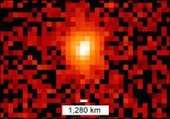
Quaoar is thought to be an oblate spheroid around 1,121 km (697 mi) in diameter, being slightly flattened in shape.[8][7] The estimates come from observations of stellar occultations by Quaoar, in which it passes in front of a star, in 2013 and 2019.[7][8] Given that Quaoar has an estimated oblateness of 0.0897±0.006 and a measured equatorial diameter of 1138+48
−34 km, Quaoar is believed to be in hydrostatic equilibrium, being described as a Maclaurin spheroid.[7] Quaoar is about as large and massive as (if somewhat smaller than) Pluto's moon Charon.[lower-alpha 4] Quaoar is roughly half the size of Pluto.[31]
Quaoar was the first trans-Neptunian object to be measured directly from Hubble Space Telescope images, using a method comparing images with the Hubble point spread function (PSF).[19] In 2004, Quaoar was estimated to have a diameter of 1,260 km (780 mi) with an uncertainty of 190 km (120 mi), using Hubble's measurements.[19][49] Given its distance Quaoar is on the limit of Hubble's resolution of 40 milliarcseconds and its image is consequently "smeared" on a few adjacent pixels.[19] By comparing carefully this image with the images of stars in the background and using a sophisticated model of Hubble optics (PSF), Brown and Trujillo were able to find the best-fit disk size that would give a similar blurred image.[19] This method was also applied by the same authors to measure the size of the dwarf planet Eris.[47]
At the time of its discovery in 2002, Quaoar was the largest object found in the Solar System since the discovery of Pluto.[31] Quaoar's size was subsequently revised downward and was later superseded in size as larger objects (Eris, Haumea, Makemake and Gonggong) were discovered. The uncorrected 2004 Hubble estimates only marginally agree with the 2007 infrared measurements by the Spitzer Space Telescope that suggest a higher albedo (0.19) and consequently a smaller diameter (844.4+206.7
−189.6 km).[47] Adopting a Uranian satellite limb darkening profile suggests that the 2004 Hubble size estimate for Quaoar was approximately 40 percent too large, and that a more proper estimate would be about 900 km.[39] In 2010, Quaoar was estimated to be about 890 km in diameter, using a weighted average of Spitzer and corrected Hubble estimates.[39] In observations of the object's shadow as it occulted an unnamed 16th-magnitude star on 4 May 2011, Quaoar was estimated to be 1,170 km (730 mi) in diameter.[49] Measurements from the Herschel Space Observatory in 2013 suggested that Quaoar has a diameter of 1,070 km (660 mi).[12] In that same year, Quaoar occulted a 15.8 magnitude star, yielding a chord length of 1100±5 km, consistent with the Herschel estimate.[7] Another occultation by Quaoar in June 2019 also yielded a similar chord length of 1121±1.2 km.[8]
Cryovolcanism
In 2004, signs of crystalline ice were found on Quaoar, indicating that the temperature rose to at least 110 K (−163 °C) sometime in the last ten million years.[20] Speculation began as to what could have caused Quaoar to heat up from its natural temperature of 55 K (−218.2 °C). Some have theorized that a barrage of mini-meteors may have raised the temperature, but the most discussed theory speculates that cryovolcanism may be occurring, spurred by the decay of radioactive elements within Quaoar's core.[20] Since then (2006), crystalline water ice was also found on Haumea, but present in larger quantities and thought to be responsible for the very high albedo of that object (0.7).[50] More precise observations of Quaoar's near infrared spectrum in 2007 indicated the presence of small quantities (5%) of solid methane and ethane. Given its boiling point of 112 K (−161 °C), methane is a volatile ice at average surface temperatures of Quaoar, unlike water ice or ethane. Both models and observations suggest that only a few larger bodies (Pluto, Eris, and Makemake) can retain the volatile ices whereas the dominant population of small TNOs lost them. Quaoar, with only small amounts of methane, appears to be in an intermediary category.[21]
Orbit and classification


Quaoar orbits the Sun at an average distance of 43.7 astronomical units (6.54×109 km; 4.06×109 mi), taking 288.8 years to complete one full orbit around the Sun. With an orbital eccentricity of 0.04, Quaoar follows a nearly circular orbit, only slightly varying in distance from 42 AU at perihelion to 45 AU at aphelion.[3] At such distances, light from the Sun takes more than 5 hours to reach Quaoar.[25] Quaoar has last passed aphelion in late 1932 and is currently approaching the Sun at a rate of 0.035 AU per year, or about 0.17 kilometers per second (380 mph).[51] Quaoar will reach perihelion in late 2066.[3]
Because Quaoar has a nearly circular orbit, it does not approach close to Neptune such that its orbit can become significantly perturbed under the gravitational influence of Neptune.[4] Quaoar's minimum orbit intersection distance from Neptune is only 12.3 AU—it does not approach Neptune within this distance over the course of its orbit, as it is not in a mean-motion orbital resonance with Neptune.[1][4] Simulations by the Deep Ecliptic Survey show that the perihelion and aphelion distances of Quaoar's orbit do not change significantly over the next 10 million years; Quaoar's orbit appears to be stable over the long term.[4]
Quaoar is generally classified as a trans-Neptunian object or distant minor planet by the Minor Planet Center since it orbits in the outer Solar System beyond Neptune.[3][1] Since Quaoar is not in a mean-motion resonance with Neptune, it is also classified as a classical Kuiper belt object (cubewano) by the Minor Planet Center and Deep Ecliptic Survey.[5][4] Quaoar's orbit is moderately inclined to the ecliptic plane by 8 degrees, relatively high when compared to the inclinations of Kuiper belt objects within the dynamically cold population.[31][52] Because Quaoar's orbital inclination is greater than 4 degrees, it is part of the dynamically hot population of high-inclination classical Kuiper belt objects.[52] The high inclinations of hot classical Kuiper belt objects such as Quaoar are thought to have resulted from gravitational scattering by Neptune during its outward migration in the early Solar System.[53]
Rotation
Quaoar's rotation period is uncertain, and two possible rotation periods of Quaoar are given (8.64 hours or 17.68 hours).[11] Derived from the rotational light curves of Quaoar observed on March through June 2003, its rotation period is measured to be 17.6788 hours.[13]
Satellite
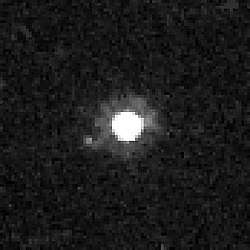
Quaoar has one known moon, Weywot (full designation (50000) Quaoar I Weywot), discovered in 2006.[6] It is thought to be somewhere around 170 km (110 mi) in diameter.[22]
Exploration
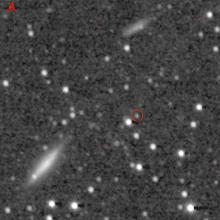
It was calculated that a flyby mission to Quaoar could take 13.57 years using a Jupiter gravity assist, based on launch dates of 25 December 2016, 22 November 2027, 22 December 2028, 22 January 2030 or 20 December 2040. Quaoar would be 41 to 43 AU from the Sun when the spacecraft arrives.[54] In July 2016, the Long Range Reconnaissance Imager (LORRI) aboard the New Horizons spacecraft took a sequence of four images of Quaoar from a distance of about 14 AU.[55] Pontus Brandt at Johns Hopkins Applied Physics Laboratory and his colleagues have studied an interstellar probe that would potentially fly by Quaoar in the 2030s before continuing to the interstellar medium.[56][57] Quaoar has been chosen as a flyby target for such a mission particularly for its escaping methane atmosphere and possible cryovolcanism, as well as its close proximity to the heliospheric nose.[56]
Notes
- According to Brown, Quaoar is correctly pronounced with three syllables. Trujillo's website on Quaoar gives a three-syllable pronunciation, /ˈkwɑːoʊ(w)ɑːr/, as an approximation of the Tongva pronunciation [ˈkʷaʔuwar].[25] However, the name can be also pronounced as two syllables, /ˈkwɑːwɑːr/, reflecting the usual English spelling and pronunciation of the deity, Kwawar.[30][34]
- Polar dimension calculated by multiplying the measured equatorial diameter 1138+48
−34 km with the oblateness 0.0897 obtained from the occultation in 2013.[7] - In the convention for minor planet provisional designations, the first letter represents the half-month of the year of discovery while the second letter and numbers indicate the order of discovery within that half-month. In the case for 2002 LM60, the first letter 'L' corresponds to the first half-month of May 2002 while the preceding letter 'M' indicates that it is the 12th object discovered on the 61st cycle of discoveries (with 60 cycles completed). Each completed cycle consists of 25 letters representing discoveries, hence 12 + (60 completed cycles × 25 letters) = 1,512.[33]
- Charon's mass is (1.586±0.015)×1021 kg[48] while Quaoar's mass is (1.4±0.1)×1021 kg.[12] Both values are approximately similar, though Charon is slightly more massive. In a similar case, Charon's diameter is 1212±1 km while Quaoar's diameter is 1121±1.2 km, being slightly smaller than Charon.
References
- "50000 Quaoar (2002 LM60)". Minor Planet Center. International Astronomical Union. Retrieved 30 November 2017.
- Schmadel, Lutz D. (2006). "(50000) Quaoar". Dictionary of Minor Planet Names – (50000) Quaoar, Addendum to Fifth Edition: 2003–2005. Springer Berlin Heidelberg. p. 1197. doi:10.1007/978-3-540-29925-7. ISBN 978-3-540-00238-3.
- "JPL Small-Body Database Browser: 50000 Quaoar (2002 LM60)" (2019-08-31 last obs.). Jet Propulsion Laboratory. 24 September 2019. Retrieved 20 February 2020.
- Buie, M. W. "Orbit Fit and Astrometric record for 50000". Southwest Research Institute. Retrieved 27 February 2018.
- Marsden, Brian G. (17 July 2008). "MPEC 2008-O05 : Distant Minor Planets (2008 Aug. 2.0 TT)". Minor Planet Electronic Circular. Minor Planet Center. Retrieved 27 February 2018.
- Green, Daniel W. E., ed. (22 February 2007). "Satellites of 2003 AZ_84, (50000), (55637), and (90482)". International Astronomical Union Circular. No. 8812. International Astronomical Union. Bibcode:2007IAUC.8812....1B. ISSN 0081-0304. Archived from the original on 19 July 2011.
- Braga-Ribas, F.; Sicardy, B.; Ortiz, J. L.; Lellouch, E.; Tancredi, G.; Lecacheux, J.; et al. (August 2013). "The Size, Shape, Albedo, Density, and Atmospheric Limit of Transneptunian Object (50000) Quaoar from Multi-chord Stellar Occultations". The Astrophysical Journal. 773 (1): 13. Bibcode:2013ApJ...773...26B. doi:10.1088/0004-637X/773/1/26. hdl:11336/1641.
- Arimatsu, Ko; Ohsawa, Ryou; Hashimoto, George L.; Urakawa, Seitaro; Takahashi, Jun; Tozuka, Miyako; et al. (December 2019). "New constraint on the atmosphere of (50000) Quaoar from a stellar occultation". The Astronomical Journal. 158 (6): 7. arXiv:1910.09988. Bibcode:2019AJ....158..236A. doi:10.3847/1538-3881/ab5058.
- "Ellipsoid surface area: 3.82769×10^6 km²". WolframAlpha. Retrieved 8 January 2020.
- "Ellipsoid volume: 7.02494×10^8 km³". WolframAlpha. Retrieved 8 January 2020.
- Fraser, Wesley C.; Batygin, Konstantin; Brown, Michael E.; Bouchez, Antonin (January 2013). "The mass, orbit, and tidal evolution of the Quaoar-Weywot system". Icarus. 222 (1): 357–363. arXiv:1211.1016. Bibcode:2013Icar..222..357F. CiteSeerX 10.1.1.441.8949. doi:10.1016/j.icarus.2012.11.004.
- Fornasier, S.; Lellouch, E.; Müller, T.; Santos-Sanz, P.; Panuzzo, P.; Kiss, C.; et al. (July 2013). "TNOs are Cool: A survey of the trans-Neptunian region. VIII. Combined Herschel PACS and SPIRE observations of nine bright targets at 70-500 µm". Astronomy & Astrophysics. 555 (A15): 22. arXiv:1305.0449v2. Bibcode:2013A&A...555A..15F. doi:10.1051/0004-6361/201321329.
- Ortiz, J. L.; Gutiérrez, P. J.; Casanova, V.; Teixeira, V. R. (October 2003). "Rotational brightness variations in Trans-Neptunian Object 50000 Quaoar" (PDF). Astronomy & Astrophysics. 409 (2): L13–L16. Bibcode:2003A&A...409L..13O. doi:10.1051/0004-6361:20031253.
- Fraser, Wesley C.; Trujillo, Chad; Stephens, Andrew W.; Gimeno, German; Brown, Michael E.; Gwyn, Stephen; Kavelaars, J. J. (September 2013). "Limits on Quaoar's Atmosphere". The Astrophysical Journal Letters. 774 (2): 4. arXiv:1308.2230. Bibcode:2013ApJ...774L..18F. doi:10.1088/2041-8205/774/2/L18.
- Tegler, Stephen C. (1 February 2007). "Kuiper Belt Object Magnitudes and Surface Colors". Northern Arizona University. Archived from the original on 1 September 2006. Retrieved 27 February 2018.
- Belskaya, Irina N.; Barucci, Maria A.; Fulchignoni, Marcello; Lazzarin, M. (April 2015). "Updated taxonomy of trans-neptunian objects and centaurs: Influence of albedo". Icarus. 250: 482–491. Bibcode:2015Icar..250..482B. doi:10.1016/j.icarus.2014.12.004.
- "LCDB Data for (50000) Quaoar". Asteroid Lightcurve Database. Retrieved 30 November 2017.
- Grundy, Will (5 November 2019). "Quaoar and Weywot (50000 2002 LM60)". Lowell Observatory. Retrieved 2 December 2019.
- Brown, Michael E.; Trujillo, Chadwick A. (April 2004). "Direct Measurement of the Size of the Large Kuiper Belt Object (50000) Quaoar" (PDF). The Astronomical Journal. 127 (4): 2413–2417. Bibcode:2004AJ....127.2413B. doi:10.1086/382513.
- Jewitt, David C.; Luu, Jane (December 2004). "Crystalline water ice on the Kuiper belt object (50000) Quaoar" (PDF). Nature. 432 (7018): 731–733. Bibcode:2004Natur.432..731J. doi:10.1038/nature03111. PMID 15592406.
- Schaller, E. L.; Brown, M. E. (November 2007). "Detection of Methane on Kuiper Belt Object (50000) Quaoar". The Astrophysical Journal. 670 (1): L49–L51. arXiv:0710.3591. Bibcode:2007ApJ...670L..49S. doi:10.1086/524140.
- Kretlow, M. (January 2020). "Beyond Jupiter – (50000) Quaoar" (PDF). Journal for Occultation Astronomy. 10 (1): 24–31. Bibcode:2020JOA....10a..24K.
- Trujillo, Chad. "Quaoar Precoveries". www.chadtrujillo.com. Archived from the original on 6 December 2002. Retrieved 30 November 2017.
- Trujillo, C. A.; Brown, M. E. (June 2003). "The Caltech Wide Area Sky Survey" (PDF). Earth, Moon, and Planets. 92 (1): L13–L16. Bibcode:2003EM&P...92...99T. doi:10.1023/B:MOON.0000031929.19729.a1.
- Trujillo, Chad. "Frequently Asked Questions About Quaoar". physics.nau.edu. Northern Arizona University. Archived from the original on 11 February 2007. Retrieved 30 November 2017.
- Marsden, Brian G. (7 October 2002). "MPEC 2002-T34 : 2002 LM60". Minor Planet Electronic Circular. Minor Planet Center. Retrieved 8 January 2020.
- "A Cold New World". NASA Science. NASA. 7 October 2002. Retrieved 8 January 2020.
- Nadin, Elisabeth (7 October 2002). "Caltech scientists find largest object in solar system since Pluto's discovery". Caltech Matters. California Institute of Technology. Retrieved 8 January 2020.
- Wilford, John Noble (8 October 2002). "Telescopes Find a Miniplanet At the Solar System's Edge". The New York Times. Retrieved 8 January 2020.
- "Hubble Spots an Icy World Far Beyond Pluto". HubbleSite. Space Telescope Science Institute. 7 October 2002. Archived from the original on 2 August 2007.
- Brown, Michael E. (7 December 2010). "Chapter Five: An Icy Nail". How I Killed Pluto and Why It Had It Coming. Spiegel & Grau. pp. 63–85. ISBN 978-0-385-53108-5.
- Brown, Michael E. (18 June 2002). "Direct Measurement of the Size of the Largest Kuiper Belt Object". Mikulski Archive for Space Telescopes. Space Telescope Science Institute: 9678. Bibcode:2002hst..prop.9678B. Retrieved 8 January 2020.
- "How Are Minor Planets Named?". Minor Planet Center. International Astronomical Union. Retrieved 5 January 2017.
- Street, Nick (August 2008). "Heavenly Bodies and the People of the Earth". Search Magazine. Heldref Publications. Archived from the original on 18 May 2009. Retrieved 8 January 2020.
- Marsden, Brian G. (28 September 2004). "MPEC 2004-S73 : Editorial Notice". Minor Planet Electronic Circular. Minor Planet Center. Retrieved 8 January 2020.
- "M.P.C. 47066" (PDF). Minor Planet Center. International Astronomical Union. 20 November 2002. Retrieved 4 December 2019.
- "M.P.C. 41805" (PDF). Minor Planet Center. International Astronomical Union. 9 January 2001. Retrieved 15 March 2019.
- Lellouch, E.; Santos-Sanz, P.; Lacerda, P.; Mommert, M.; Duffard, R.; Ortiz, J. L.; et al. (September 2013). ""TNOs are Cool": A survey of the trans-Neptunian region. IX. Thermal properties of Kuiper belt objects and Centaurs from combined Herschel and Spitzer observations" (PDF). Astronomy & Astrophysics. 557 (A60): 19. Bibcode:2013A&A...557A..60L. doi:10.1051/0004-6361/201322047.
- Fraser, Wesley C.; Brown, Michael E. (May 2010). "Quaoar: A Rock in the Kuiper Belt". The Astrophysical Journal. 714 (2): 1547–1550. arXiv:1003.5911. Bibcode:2010ApJ...714.1547F. doi:10.1088/0004-637X/714/2/1547.
- Brown, Michael E. (2008). "The Largest Kuiper Belt Objects" (PDF). The Solar System Beyond Neptune. University of Arizona Press. pp. 335–344. Bibcode:2008ssbn.book..335B. ISBN 978-0-8165-2755-7.
- Hussmann, Hauke; Sohl, Frank; Spohn, Tilman (November 2006). "Subsurface oceans and deep interiors of medium-sized outer planet satellites and large trans-neptunian objects". Icarus. 185 (1): 258–273. Bibcode:2006Icar..185..258H. doi:10.1016/j.icarus.2006.06.005.
- Brown, Michael E. "The Dwarf Planets". California Institute of Technology. Retrieved 27 February 2018.
- "The IAU draft definition of "planet" and "plutons"" (Press release). International Astronomical Union. August 2006. Retrieved 27 February 2018.
- Brown, Michael E. "How many dwarf planets are there in the outer solar system?". California Institute of Technology. Retrieved 27 February 2018.
- Tancredi, G.; Favre, S. (July 2008). Which are the dwarfs in the solar system? (PDF). Asteroids, Comets, Meteors. Lunar and Planetary Institute. Bibcode:2008LPICo1405.8261T. 8261.
- Musser, George (13 October 2009). "What do we really know about the Kuiper Belt? Fifth dispatch from the annual planets meeting". Scientific American. Archived from the original on 14 October 2009.
- Stansberry, John; Grundy, Will; Brown, Mike; Cruikshank, Dale; Spencer, John; Trilling, David; Margot, Jean-Luc (2008). "Physical Properties of Kuiper Belt and Centaur Objects: Constraints from the Spitzer Space Telescope" (PDF). The Solar System Beyond Neptune. University of Arizona Press. pp. 161–179. arXiv:astro-ph/0702538. Bibcode:2008ssbn.book..161S. ISBN 978-0-8165-2755-7.
- Stern, S. A.; Grundy, W.; McKinnon, W. B.; Weaver, H. A.; Young, L. A.; Young, L. A.; et al. (September 2018). "The Pluto System After New Horizons". Annual Review of Astronomy and Astrophysics. 56: 357–392. arXiv:1712.05669. Bibcode:2018ARA&A..56..357S. doi:10.1146/annurev-astro-081817-051935.
- Braga-Ribas, F.; Sicardy, B.; Ortiz, J. L.; Jehin, E.; Camargo, J. I. B.; Assafin, M.; et al. (October 2011). Stellar Occultations by TNOs: the January 08, 2011 by (208996) 2003 AZ84 and the May 04, 2011 by (50000) Quaoar (PDF). EPSC-DPS Joint Meeting 2011. 6. European Planetary Science Congress.
- Truijillo, Chadwick A.; Brown, Michael E.; Barkume, Kristina M.; Schaller, Emily L.; Rabinowitz, David L. (February 2007). "The Surface of 2003EL61 in the Near Infrared". The Astrophysical Journal. 655 (2): 1172–1178. arXiv:astro-ph/0601618. Bibcode:2007ApJ...655.1172T. doi:10.1086/509861.
- "Horizon Online Ephemeris System for 50000 Quaoar (2002 LM60)" ((Select Ephemeris Type: Observer, Observer Location: @sun, and Time Span: Start=1932-01-01, Step=1 d)). Jet Propulsion Laboratory. Retrieved 24 January 2020.
- Delsanti, Audrey; Jewitt, David (2006). "The Solar System Beyond The Planets" (PDF). In Blonde, P.; Mason, J. (eds.). Solar System Update. Springer. pp. 267–293. Bibcode:2006ssu..book..267D. doi:10.1007/3-540-37683-6_11. ISBN 3-540-26056-0. Archived from the original (PDF) on 25 September 2007.
- Levison, Harold F.; Morbidelli, Alessandro; Van Laerhoven, Christa; Gomes, Rodney S.; Tsiganis, Kleomenis (July 2008). "Origin of the Structure of the Kuiper Belt during a Dynamical Instability in the Orbits of Uranus and Neptune". Icarus. 196 (1): 258–273. arXiv:0712.0553. Bibcode:2008Icar..196..258L. doi:10.1016/j.icarus.2007.11.035.
- McGranaghan, Ryan; Sagan, Brent; Dove, Gemma; Tullos, Aaron; Lyne, James E.; Emery, Joshua P. (September 2011). "A Survey of Mission Opportunities to Trans-Neptunian Objects". Journal of the British Interplanetary Society. 64: 296–303. Bibcode:2011JBIS...64..296M.
- "New Horizons Spies a Kuiper Belt Companion". pluto.jhuapl.edu. Johns Hopkins University Applied Physics Laboratory. 31 August 2016. Archived from the original on 15 November 2017. Retrieved 7 September 2016.
- Brandt, Pontus C.; McNutt, R.; Hallinan, G.; Shao, M.; Mewaldt, R.; Brown, M.; et al. (February 2017). The Interstellar Probe Mission: Humanity's First Explicit Step in Reaching Another Star (PDF). Planetary Science Vision 2050 Workshop. Lunar and Planetary Institute. Bibcode:2017LPICo1989.8173B. 8173. Retrieved 24 July 2018.
- Runyon, K. D.; Mandt, K.; Stern, S. A.; Brandt, P. C.; McNutt, R. L. (December 2018). Kuiper Belt Planet Geoscience from Interstellar Probe. AGU Fall Meeting 2018. American Geophysical Union. Bibcode:2018AGUFMSH32C..10R. SH32C-10. Retrieved 30 March 2019.
External links
| Wikimedia Commons has media related to Quaoar. |
- Frequently Asked Questions About Quaoar
- Quaoar could have hit a bigger Pluto-sized body at high speeds (Video Credit: Craig Agnor, E. Asphaug)
- Chilly Quaoar had a warmer past – Nature.com article
- Quaoar: Planetoid Beyond Pluto – SPACE.com article by Elizabeth Howell
- Beyond Jupiter – (50000) Quaoar
- 50000 Quaoar at AstDyS-2, Asteroids—Dynamic Site
- 50000 Quaoar at the JPL Small-Body Database

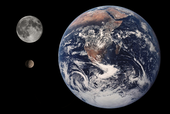
_(cropped).jpg)
